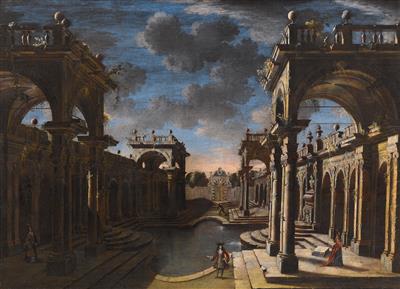Antonio Visentini

(Venice 1688–1782)
Elegant figures in an idealised architectural landscape,
oil on canvas, 96 x 130.5 cm, framed
Literature:
G. Sestieri, Il Capriccio architettonico in Italia nel XVII e XVIII secolo, Foligno 2015, vol. III, pp. 304-305, n. 8, illustrated
This veduta represents the courtyard of a palace enclosed by lateral arched porticoes with a poly-lobed fountain centrally positioned and further enclosed by four logge surmounted by balconies. In the distance, beyond the entrance gate and the enclosing perimeter wall, trees can be glimpsed, suggesting a country setting for this grand residence with its vast court. The scene is animated by a few figures whose rich clothing, like the elaborate architecture and the extent of the porticoes, highlights the sumptuous nature of the setting. However, the vegetation that emerges from certain architectural elements in ruin, clearly picked out by the warm evening light of dusk, contributes an atmosphere of abandon to the scene. This poignant conception of decline, united with a certain appeal to the antique, suggested by the two small funerary monuments surmounted by busts to each side of the courtyard, allow us to include this work within the genre of architectural capricci: views that are partially real and partially imaginary. Antonio Visentini’s are among the most able interpretations of such scenes inspired by classical antiquity, wherein architectural elements blend into landscape.
Visentini was a highly talented figure in Settecento Venice: a painter, engraver, draughtsman, architect and professor of architectural perspective at the Academy. Over the course of his long career he bridged all the artistic currents that embraced the lagoon city from the baroque extravagances of the early years of the century, through to the radical transformations of neoclassicism. Following his early training with Giovanni Antonio Pellegrini, from whom he learnt the spontaneous vivacity with which he depicts the figures of his compositions, Visentini next demonstrated an absolute admiration for the art of Palladio and for antiquity. This emerges with full force in his capricci, which remained startlingly free of any reference to the iconography of Venice. The work under discussion here is exemplary of this for its sense of unified space and its control of chiaroscuro. In style it also recalls certain inventions present in the series of views he produced for Palazzo Contarini Bisacco before 1739, wherein the architecture, rather than recalling an urban setting, recalls the countryside pleasure villas of the Venetian aristocracy.
25.04.2017 - 18:00
- Prezzo realizzato: **
-
EUR 25.000,-
- Stima:
-
EUR 20.000,- a EUR 30.000,-
Antonio Visentini
(Venice 1688–1782)
Elegant figures in an idealised architectural landscape,
oil on canvas, 96 x 130.5 cm, framed
Literature:
G. Sestieri, Il Capriccio architettonico in Italia nel XVII e XVIII secolo, Foligno 2015, vol. III, pp. 304-305, n. 8, illustrated
This veduta represents the courtyard of a palace enclosed by lateral arched porticoes with a poly-lobed fountain centrally positioned and further enclosed by four logge surmounted by balconies. In the distance, beyond the entrance gate and the enclosing perimeter wall, trees can be glimpsed, suggesting a country setting for this grand residence with its vast court. The scene is animated by a few figures whose rich clothing, like the elaborate architecture and the extent of the porticoes, highlights the sumptuous nature of the setting. However, the vegetation that emerges from certain architectural elements in ruin, clearly picked out by the warm evening light of dusk, contributes an atmosphere of abandon to the scene. This poignant conception of decline, united with a certain appeal to the antique, suggested by the two small funerary monuments surmounted by busts to each side of the courtyard, allow us to include this work within the genre of architectural capricci: views that are partially real and partially imaginary. Antonio Visentini’s are among the most able interpretations of such scenes inspired by classical antiquity, wherein architectural elements blend into landscape.
Visentini was a highly talented figure in Settecento Venice: a painter, engraver, draughtsman, architect and professor of architectural perspective at the Academy. Over the course of his long career he bridged all the artistic currents that embraced the lagoon city from the baroque extravagances of the early years of the century, through to the radical transformations of neoclassicism. Following his early training with Giovanni Antonio Pellegrini, from whom he learnt the spontaneous vivacity with which he depicts the figures of his compositions, Visentini next demonstrated an absolute admiration for the art of Palladio and for antiquity. This emerges with full force in his capricci, which remained startlingly free of any reference to the iconography of Venice. The work under discussion here is exemplary of this for its sense of unified space and its control of chiaroscuro. In style it also recalls certain inventions present in the series of views he produced for Palazzo Contarini Bisacco before 1739, wherein the architecture, rather than recalling an urban setting, recalls the countryside pleasure villas of the Venetian aristocracy.
|
Hotline dell'acquirente
lun-ven: 10.00 - 17.00
old.masters@dorotheum.at +43 1 515 60 403 |
| Asta: | Dipinti antichi |
| Tipo d'asta: | Asta in sala |
| Data: | 25.04.2017 - 18:00 |
| Luogo dell'asta: | Vienna | Palais Dorotheum |
| Esposizione: | 15.04. - 25.04.2017 |
** Prezzo d’acquisto comprensivo dei diritti d’asta acquirente e IVA
Non è più possibile effettuare un ordine di acquisto su Internet. L'asta è in preparazione o è già stata eseguita.
